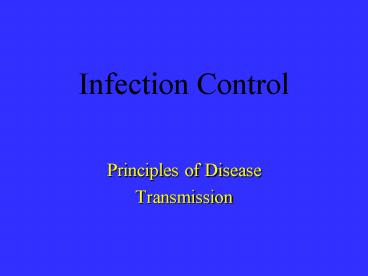Infection Control - PowerPoint PPT Presentation
1 / 35
Title:
Infection Control
Description:
Classified by shape and arrangement. Cocci strep, staph. Bacilli TB, tetanus ... Ringworm,athlete's foot, thrush. Rickettsiae - Parasitic microorganism ... – PowerPoint PPT presentation
Number of Views:158
Avg rating:3.0/5.0
Title: Infection Control
1
Infection Control
- Principles of Disease
- Transmission
2
Microorganisms
- Small living plant or animal
- Non-pathogens
- Live in or on the body
- Part of the normal flora
- May be beneficial to the body
- Pathogens
- Germs
- Cause infection
3
Types of Pathogens
- Bacteria
- One celled plants
- Classified by shape and arrangement
- Cocci strep, staph
- Bacilli TB, tetanus
- Spirilla syphilis, cholera
4
- Protazoa
- One celled animals
- Found in decayed material and contaminated water
- Malaria, dysentery
5
- Fungi
- Simple plant-like organism
- Live on dead matter
- Yeasts, molds
- Ringworm,athletes foot, thrush
6
Rickettsiae
- - Parasitic microorganism
- Transmitted to humans through the bite of a
tick,fleas, Typhus and lice, mites - Rocky Mountain spotted fever
7
- Viruses
- Smallest microorganism
- Can only reproduce inside humans cells
- Colds, chicken pox, warts, influenza, HIV,
Hepatitis
8
Needs of microorganisms
- To Grow
- Warmth
- Darkness
- Source of food
- Moisture
- Aerobic need oxygen
- Anaerobic dont need oxygen
9
How Pathogens Cause Infections
- Poisons/toxins
- Ex tetanus
- Allergic Reactions
- Ex runny nose, sneezing
- Attack and Destroy cells they invade
- Ex malaria
10
Additional Classifications
- Endogenous
- Originates inside the body
- Exogenous
- Originates outside the body
- Nonsocomial
- An infection acquired inside the hospital
- Opportunistic
- Infections that occur when the bodys immune
system is weak
11
Chain of Infection
12
Asepsis
- Absence of disease-producing microorganisms
- Any area or object containing pathogens is
considered contaminated
13
Levels of aseptic Control
- Antisepsis
- Prevent or inhibit the growth of pathogenic
organism but are not effective against spores or
viruses. - Ex Alcohol/Betadine
14
Disinfection
- Destroys or kills pathogenic organisms but not
always effective against spores or viruses - Ex Bleach, Clorox
15
Sterilization
- The process that destroys all microorganisms both
pathogenic and non-pathogenic including spores
and viruses. - Ex Steam under pressure, autoclave, gas,
radiation, chemicals
16
Most Inexpensive, Quickest, and Effective way to
prevent the spread of pathogens
17
(No Transcript)
18
Standard Precautions
19
Two Main Ways Pathogens Spread
- Blood
- HIV
- Hepatitis B
- Hepatitis C
- Body Fluids
20
OSHA
- Occupational Safety and Health Administration
- 1991 established
- blood-borne pathogen
- standard regulations
21
Regulations
- Determine employees who have occupational
exposure - Provide the Hepatitis B vaccine free
- Provide PPE Personal Protective Equipment
- Provide adequate hand washing facilities
- Ensure the worksite is maintained in a clean and
sanitary condition
22
Regulations Cont.
- Enforce NO eating , drinking, smoking, applying
lip balm or lipstick, handling contact lenses or
mouth pipetting in any area potentially
contaminated with blood or body fluids. - Provide adequate sharps containers coded
red/orange - Post signs in areas where there is occupational
exposure
23
- Provide confidential medical evaluation and
follow up for any employee with an exposure - Provide free training for any new updates or
changes
24
Sharps
- all needles
- syringes
- syringe bodies
- scalpels
- lancets
- any glass items, such as slides or Pasteur
pipettes, that are contaminated with potentially
infectious material and/or human blood.
25
26
PPE
- Personal
- Protective
- Equipment
27
Sterile Technique
- Sterile
- Free from all organisms
- Contaminated
- Organisms and pathogens are present
- Items that touch your clothes or skin or any area
below the waist are considered contaminated
28
Sterile Field
- Never reach across the top of the field
- Reach in from the sides to add to the field
- Never turn your back to a sterile field
- 2 inches around the border are contaminated
- Anything below the level of the tray is
contaminated
29
Methods to Remove Sterile Articles from Sterile
Wraps
- Drop Method
- Mitten Method
- Transfer Forceps
30
Sterile Field
- Keep Sterile field dry
- Pathogens move quickly through wet surfaces
- Take care when pouring solutions into a sterile
field - When you put on sterile gloves, only handle
sterile items
31
(No Transcript)
32
Standards Precaustions
- Used when contacting all patients
33
Transmission-based Isolation
- Airborne
- Droplet
- Contact
- Protective
34
Communicable Diseases
- A disease caused by a pathogic organism that can
be easily transmitted to others - Spread by
- Direct contact with patient
- Contact with blood and body fluids
- Droplets
- Discharge from wounds
35
(No Transcript)































